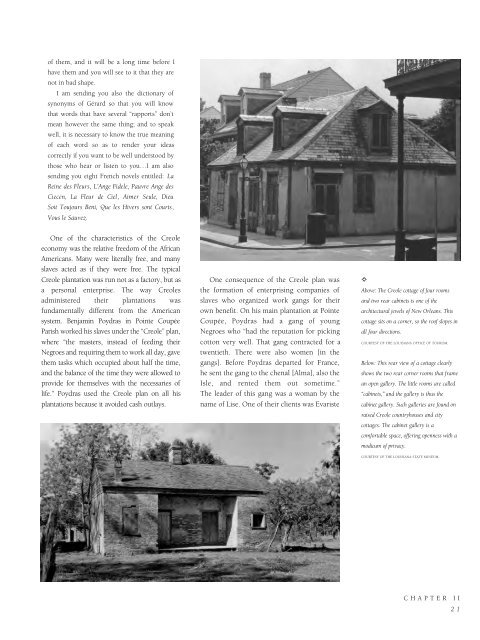Historic Louisiana
An illustrated history of Louisiana, paired with the histories of companies, families and organizations that make the state great.
An illustrated history of Louisiana, paired with the histories of companies, families and organizations that make the state great.
You also want an ePaper? Increase the reach of your titles
YUMPU automatically turns print PDFs into web optimized ePapers that Google loves.
of them, and it will be a long time before I<br />
have them and you will see to it that they are<br />
not in bad shape.<br />
I am sending you also the dictionary of<br />
synonyms of Gérard so that you will know<br />
that words that have several “rapports” don’t<br />
mean however the same thing; and to speak<br />
well, it is necessary to know the true meaning<br />
of each word so as to render your ideas<br />
correctly if you want to be well understood by<br />
those who hear or listen to you…I am also<br />
sending you eight French novels entitled: La<br />
Reine des Fleurs, L’Ange Fidele, Pauvre Ange des<br />
Ciecen, La Fleur de Ciel, Aimer Seule, Dieu<br />
Soit Toujours Beni, Que les Hivers sont Courts,<br />
Vous le Sauvez.<br />
One of the characteristics of the Creole<br />
economy was the relative freedom of the African<br />
Americans. Many were literally free, and many<br />
slaves acted as if they were free. The typical<br />
Creole plantation was run not as a factory, but as<br />
a personal enterprise. The way Creoles<br />
administered their plantations was<br />
fundamentally different from the American<br />
system. Benjamin Poydras in Pointe Coupée<br />
Parish worked his slaves under the “Creole” plan,<br />
where “the masters, instead of feeding their<br />
Negroes and requiring them to work all day, gave<br />
them tasks which occupied about half the time,<br />
and the balance of the time they were allowed to<br />
provide for themselves with the necessaries of<br />
life.” Poydras used the Creole plan on all his<br />
plantations because it avoided cash outlays.<br />
One consequence of the Creole plan was<br />
the formation of enterprising companies of<br />
slaves who organized work gangs for their<br />
own benefit. On his main plantation at Pointe<br />
Coupée, Poydras had a gang of young<br />
Negroes who “had the reputation for picking<br />
cotton very well. That gang contracted for a<br />
twentieth. There were also women [in the<br />
gangs]. Before Poydras departed for France,<br />
he sent the gang to the chenal [Alma], also the<br />
Isle, and rented them out sometime.”<br />
The leader of this gang was a woman by the<br />
name of Lise. One of their clients was Evariste<br />
✧<br />
Above: The Creole cottage of four rooms<br />
and two rear cabinets is one of the<br />
architectural jewels of New Orleans. This<br />
cottage sits on a corner, so the roof slopes in<br />
all four directions.<br />
COURTESY OF THE LOUISIANA OFFICE OF TOURISM.<br />
Below: This rear view of a cottage clearly<br />
shows the two rear corner rooms that frame<br />
an open gallery. The little rooms are called<br />
“cabinets,” and the gallery is thus the<br />
cabinet gallery. Such galleries are found on<br />
raised Creole countryhouses and city<br />
cottages. The cabinet gallery is a<br />
comfortable space, offering openness with a<br />
modicum of privacy.<br />
COURTESY OF THE LOUISIANA STATE MUSEUM.<br />
CHAPTER II<br />
21
















